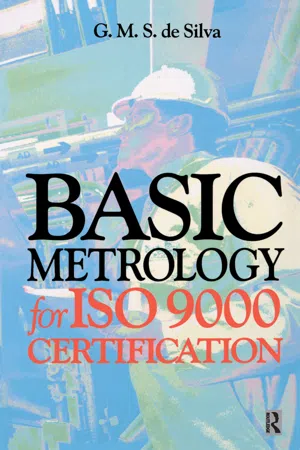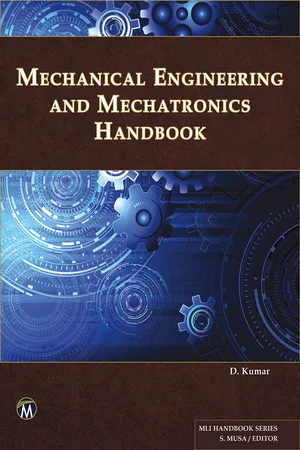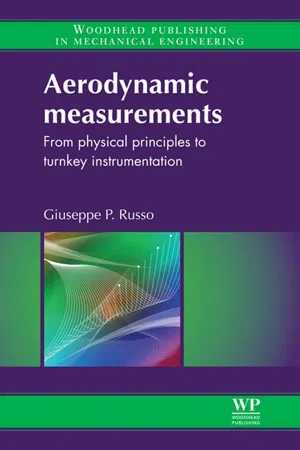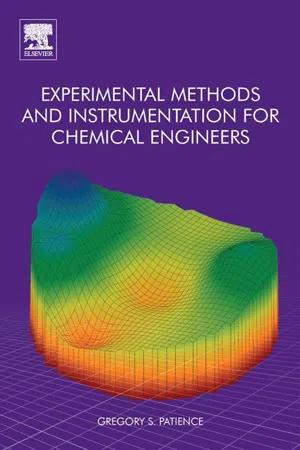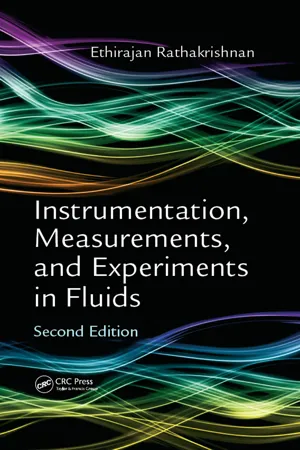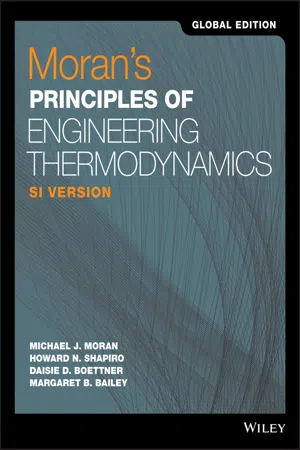Technology & Engineering
Manometer
A manometer is a device used to measure pressure, typically in a closed system. It consists of a U-shaped tube filled with a liquid, with one end connected to the system being measured. The difference in liquid levels in the two arms of the U-tube indicates the pressure in the system.
Written by Perlego with AI-assistance
Related key terms
Related key terms
1 of 4
Related key terms
1 of 3
10 Key excerpts on "Manometer"
- eBook - ePub
- G. M. S. de Silva(Author)
- 2012(Publication Date)
- Routledge(Publisher)
Fig. 5.11 .Figure 5.11 U tube ManometerThe fundamental principle that the absolute pressure on the same horizontal plane in a given liquid is constant is used in the U tube Manometer. In mathematical form this principle is expressed in the following equation:
where:(5.13) P1 and P2 = pressure at points 1 and 2 h = the difference of height between the fluid levels of the two limbs ρ = the density of manometric liquid g = local acceleration due to gravity. If P1 = P2, that is when both ends of the U tube are subjected to the same pressure, the levels of the liquid column will be at the same horizontal level. If, however, one limb is at a higher pressure than the other, the liquid column in that limb is depressed. The pressure difference between the two limbs is read off as the difference in heights of the liquid columns in the two limbs.Mercury, water and oil are all used in various designs of Manometer. For measuring large pressure differences, mercury is frequently used as its density is over 13 times greater than that of water or oil and thus, for a given pressure, it requires a much shorter column. Density of mercury is also considerably more stable than that of other liquids.Water or oil liquid columns are used to measure low gauge and differential pressures. In some designs the Manometer is inclined as this increases its sensitivity, the fluid having further to travel along the inclined column to achieve a given vertical movement. The traditional units for this type of measurement were inches of water or millimetres of water, but as units they are poorly defined and as mentioned earlier their continued use is strongly discouraged.5.8.2 Mechanical deformation instruments
5.8.2.1 Bourdon tube gauge
A metallic tube of elliptical cross-section that is bent to form a circular arc is the sensing element of a Bourdon tube dial gauge. The application of a pressure to the open end of the tube straightens it out. The movement of the free end of the tube is amplified mechanically using gears and levers to operate a pointer. Bourdon tube dial gauges operate at pressures up to about 1.5 GPa and a typical mechanism is shown in Fig. 5.12 - eBook - ePub
- D. Kumar, Sarhan M. Susa(Authors)
- 2022(Publication Date)
- Mercury Learning and Information(Publisher)
7.5.1. PiezometerPressure measurement is undoubtedly one of the most common of all the measurements made on systems. In a company with temperature and flow, pressure measurements are extensively used in industry, laboratories, and many other fields for a wide variety of reasons. Pressure measurements are concerned not only with the determination of force per unit area exerted by a fluid at a point but are also involved in many liquid levels, density, flow, and temperature measurements. Measurement of pressure is also needed to maintain safe operating conditions, to help control a process, and to provide test data.Pressure measurement by any technique is essentially based on the following well-known propositions:i. Pressure at any point in a body of liquid at rest is proportional to the depth of the point below the free surface of the liquid, and increases in the downward direction at a rate equivalent to the density of the liquid. Further, within a continuous expanse of the same fluid, pressure is the same at any two points which lie in a horizontal plane.ii. There is pressure equality throughout a fluid, that is, a pressure applied to a confined fluid via a movable surface would be transferred undiminished to all the boundary surfaces.iii. Pressure is unaffected by the shape of the confining boundaries.Manometers measure pressure by balancing a column of liquid against the pressure to be measured. Height of the column so balanced is measured and then converted to the desired pressure units. Manometers may be vertical, inclined, open, differential, or compound. Choice of any type depends on its sensitivity of the measurement, ease of operation, and the magnitude of pressure being measured. Manometers can be used to measure gauge, differential atmospheric, and absolute pressures.It is a vertical transparent glass tube, the upper end of which is open to the atmosphere and the lower end is in communication with the gauge point; a point in the fluid container at which pressure is to be measured. The rise of fluid in the tube above a certain gauge point is a measure of the pressure at that point. - eBook - ePub
Aerodynamic Measurements
From Physical Principles to Turnkey Instrumentation
- G P Russo(Author)
- 2011(Publication Date)
- Woodhead Publishing(Publisher)
Data acquisition and handling . The hydrostatic or metal Manometers require manual reading and transcription of the data. Some types of transducers produce a frequency modulated signal that has to be read by a system of demodulation to obtain pressure. Obviously, the ease and certainty with which data can be interpreted and recorded are important factors in choosing a pressure sensor.1.2 Hydrostatic Manometers
In this kind of Manometer, the difference between two pressures is balanced by the difference of level in a liquid. To measure pressure in a liquid, a Manometer can use the working fluid itself, this is obviously not the case when pressure is measured in a gas: the choice of the Manometer fluid (or separating liquid) will be affected by the pressure field, the required sensitivity and the physical and chemical properties of the liquid. The properties of the most common Manometer liquids are shown in Table 1.1 .Table 1.1 Properties of the most common Manometer liquidsThe liquids that work best are those that are chemically stable, are not affected by moisture and have the following qualities: low viscosity, as this reduces the response time; low surface tension, low volumetric expansion coefficient, low volatility, consistency, and resistance to contamination.1.2.1 The U-tube Manometer
The fluid is contained in a glass tube with U -shaped vertical arms (Figure 1.1 ) with internal diameters more or less constant. The pressures p 1 and p 2 will be applied through suitable piping connection to the two arms of the Manometer. If the difference between the heights of the columns of fluid in the two arms is Δh , it will be:Figure 1.1 U -tube Manometer(1.1)where g is the acceleration of gravity andρandρaare the densities of the Manometer liquid and of air, respectively. The approximation made whenρais considered negligible with respect toρis of the order 10− 3 when water is the Manometer liquid and 10− 4 - Gregory S. Patience(Author)
- 2013(Publication Date)
- Elsevier(Publisher)
Several terms for pressure measuring devices are used interchangeably including transmitters, transducers, gauges, sensors, and Manometers. More precisely, a gauge is a self-contained device that converts a force from the process to a mechanical motion of needle or other type of pointer. A Manometer is a term reserved for an instrument that measures the hydrostatic head of a liquid and generally operates near atmospheric pressure. A transducer or transmitter combines the sensor with a power supply and a converter—generally mechanical-to-electrical or mechanical-to-pneumatic. The sensor refers to the element that is sensitive to changes in pressure and may either be a mechanical deviation or a change in electrical current.In general, pressure measurement devices may be classified as either electrical or mechanical. The first sensors were mechanical and relied on flexible elements. Because of the limitations of mechanical motion devices, wire strain gauges were then adapted to measure pressure. Capacitance transducers were developed for vacuum applications. A potentiometric device is attached to a bellows element and converts a mechanical deflection into an electrical signal using a Wheatstone bridge circuit. Resonant wire transducers measure a wide range of pressures from vacuum at 10 Torr up to 42 MPa. They consist of a wire attached to a sensing diaphragm at one end and fixed at the other. The wire vibrates at its resonant frequency due to an oscillator circuit. Changes in pressure result in a change in the resonant frequency of the wire.Factors influencing the choice of an instrument depend primarily on the pressure of the application and whether the gauge is required for control or simply as an indicator. For control, electronic transmitters are preferred whereas mechanical devices are suitable as indicators. Mechanical indicators are easy to read and interpret but may be difficult to install in tight areas or may require extensive tubing. Electronic transmitters may be easier to install in tight areas or remote connections but require a power supply and wire, as well as additional displays. The dynamic response of electrical instruments is superior to mechanical indicators since the data can be recorded at high frequency.- Ethirajan Rathakrishnan(Author)
- 2020(Publication Date)
- CRC Press(Publisher)
Various types of liquid Manometers are employed depending upon the range of pressures to be measured and the degree of precision required. The U-tube Manometers, multitube Manometers, and Betz-type Manometers are some of the popular liquid Manometers used for pressure measurements in fluid flow. The pressure transducers used for fluid flow experimentation may be classified as electrical-type transducers, mechanical-type transducers, and optical-type transducers, based on the functioning principle of the sensor in the transducer. 7.1.2 Principle of the Manometer The basic measuring principle of the liquid Manometer is that the pressure applied is balanced by the weight of a liquid column. The sensitivity of the instrument depends on the density of manometric fluid used. Some of the commonly used manometric liquids are water, alcohol, and mercury. For pressure measurements in compressible flows, with high subsonic and supersonic Mach numbers, mercury is the suitable liquid, since fluids like water and alcohol show unmanageable variations in Manometer column heights for the pressures associated with such speeds. In addition to these Manometers, an accurate barometer is essential for pressure measurements, since in Manometers the pressures are invariably measured in terms of a difference in pressure from some known reference. The most common reference is the local atmospheric pressure. Therefore, for pressures measured with reference to atmospheric pressure, conversion to absolute pressure requires that the local atmospheric pressure be known. The common mercury barometer is quite satisfactory for this purpose. When equipped with a suitable device for viewing the meniscus of the mercury column and reading the column height scale, a good barometer will allow measurement of atmospheric pressure with an accuracy of a fraction of a millimeter of mercury- eBook - ePub
- British Gas(Author)
- 2014(Publication Date)
- Routledge(Publisher)
The absolute pressure of a fluid is the difference between the fluid pressure and the pressure in a complete vacuum. Differential pressure refers to the measurement of the difference between any two pressures and gauge pressure is a differential pressure measurement in which one pressure is that of the atmosphere. Absolute pressure is always positive; differential pressure may be positive or negative.Pressure measuring instruments take various forms, depending on the magnitude of the pressure, the accuracy desired and other conditions. However, they fall into three main categories, namely Manometers, gauges and transducers. All three types can be configured to measure negative as well as positive pressures. Digital electronic Manometers based on capacitance or piezo-resistance transducers are being increasingly used both for test measurements and in permanent installations for differential pressures and pressures up to 0.25 MPa (2.5 bar).14.3.1 Manometers
Manometers work on the fundamental principle of balancing applied pressure against a liquid column of known height and density.Manometers, which may contain a wide variety of fluids depending on the pressure, are capable of high accuracy with careful use. The fluids used vary from those lighter than water for low pressures to mercury for relatively high pressures. For any given pressure, therefore, the height of the liquid column will vary according to the fluid density and the scale must be graduated to suit. The scale will typically give readings in mbar or Pascals, but there are many Manometers in current use calibrated in terms of a standard liquid column e.g. inches or millimetres of water or mercury. There are various types of Manometers available, as shown in Figure 14.11 .U-Tube Manometer
The U-tube is the simplest form of Manometer and it consists of transparent U-tube filled with liquid and connected to the point at which the differential pressure is to be measured. The difference in the levels of the liquid will vary according to the pressure acting on one let of the U-tube compared to atmospheric pressure on the other. These should be mounted truly vertically. - eBook - ePub
- James Patrick Abulencia, Louis Theodore(Authors)
- 2011(Publication Date)
- Wiley-AIChE(Publisher)
Pressure is usually measured by allowing it to act across some area and opposing it with some type of force (e.g., gravity, compressed spring, electrical, and so on). If the force is gravity, the device is usually a Manometer.A very common device to measure pressure is the Bourdon-tube pressure gauge. It is a reliable and inexpensive direct displacement device. It is made of a stiff metal tube bent in a circular shape. One end is fixed and the other is free to deflect when pressurized. This deflection is measured by a linkage attached to a calibrated dial (see Fig. 19.1 ). Bourdon gauges are available with an accuracy of ± 0.1% of the full scale.Figure 19.1 Bourdon-tube pressure gauge.Other pressure gauges measure the pressure by the displacement of the sensing element electrically. Among the common methods are capacitance, resistive and inductive. However, the interest in this section is primarily with the Manometer.Consider the open Manometer shown in Fig. 19.2 . P 1 is unknown andPais the known atmospheric pressure. The heightsza , z1 , and z 2 are also known. Applying Bernoulli’s hydrostatic equation at points 1 and 2, and again at points a and 2 yields:Figure 19.2 Open Manometer.(19.1)(19.2)If the two equations are added, one obtains:(19.3)The reader should refer to Chapter 10 for more details on manometry.Illustrative Example 19.1 Find the air pressure (P 1 ) in the oil tank pictured in Fig. 19.3 , given the heights and densities of the fluids in the Manometer. The oil has a specific gravity of 0.8, the specific gravity of mercury is 13.6, and the density of air is 1.2 kg/m3 - eBook - ePub
- John Bird(Author)
- 2019(Publication Date)
- Routledge(Publisher)
1 mm of mercury.If limb A is connected to a container of gas whose pressure is below atmospheric then the levels of mercury will move as shown in Figure 29.7(c) , such that their pressure difference is h 2 mm of mercury.It is also possible merely to compare two pressures, sayPAandPB ,using a U-tube Manometer.Figure 29.7(d) shows such an arrangement with (PB–PA) equivalent to h mm of mercury. One application of this differential pressure-measuring device is in determining the velocity of fluid flow in pipes.For the measurement of lower pressures, water or paraffin may be used instead of mercury in the U-tube to give larger values of h and thus greater sensitivity.Figure 29.729.8.2 Inclined Manometers
For the measurement of very low pressures, greater sensitivity is achieved by using an inclined Manometer, a typical arrangement of which is shown in Figure 29.8 . With the inclined Manometer the liquid used is water and the scale attached to the inclined tube is calibrated in terms of the vertical height h. Thus when a vessel containing gas under pressure is connected to the reservoir, movement of the liquid levels of the Manometer occurs. Since small-bore tubing is used the movement of the liquid in the reservoir is very small compared with the movement in the inclined tube and is thus neglected. Hence the scale on the Manometer is usually in the range 0.2 mbar to 2 mbar.Figure 29.8The pressure of a gas that a Manometer is capable of measuring is naturally limited by the length of tube used. Most Manometer tubes are less than 2 m in length and this restricts measurement to a maximum pressure of about 2.5 bar (or 250 kPa) when mercury is used. - eBook - ePub
- Michael J. Moran, Howard N. Shapiro, Daisie D. Boettner, Margaret B. Bailey(Authors)
- 2018(Publication Date)
- Wiley(Publisher)
FIG. 1.7 ManometerThe barometer shown in Fig. 1.8 is formed by a closed tube filled with liquid mercury and a small amount of mercury vapor inverted in an open container of liquid mercury. Since the pressures at points a and b are equal, a force balance gives the atmospheric pressure as(1.12)p atm=p vapor+ρ mg Lwhere ρm is the density of liquid mercury. Because the pressure of the mercury vapor is much less than that of the atmosphere, Eq. 1.12 can be approximated closely aspatm = ρm gL. For short columns of liquid, ρ and g in Eqs. 1.11 and 1.12 may be taken as constant.FIG. 1.8 BarometerPressures measured with Manometers and barometers are frequently expressed in terms of the length L in millimeters of mercury (mmHg), inches of mercury (inHg), inches of water(inH2 O), and so on.FOR EXAMPLE
A barometer reads 750 mmHg. Ifρm = 13.59 g/cm3andg = 9.81 m/s2, the atmospheric pressure, inN/m2, is calculated as follows:p atm=ρ mg L=[(]13.59)gcm 3||1 kg10 3g|3|10 2cm1 m[9.81]ms 2[( 750 mmHg )]||1 m10 3mm||1 N1 kg · m /s 2=10 5N /m 2A Bourdon tube gage is shown in Fig. 1.9 . The figure shows a curved tube having an elliptical cross section with one end attached to the pressure to be measured and the other end connected to a pointer by a mechanism. When fluid under pressure fills the tube, the elliptical section tends to become circular, and the tube straightens. This motion is transmitted by the mechanism to the pointer. By calibrating the deflection of the pointer for known pressures, a graduated scale can be determined from which any applied pressure can be read in suitable units. Because of its construction, the Bourdon tube measures the pressure relative to the pressure of the surroundings existing at the instrument. Accordingly, the dial reads zero when the inside and outside of the tube are at the same pressure.FIG. 1.9 - eBook - ePub
- Irving Granet, Jorge Alvarado, Maurice Bluestein(Authors)
- 2020(Publication Date)
- CRC Press(Publisher)
A is 109.418 kPa. Continuing around the Manometer until the water pipe is reached, we add 0.3 m of mercury, subtract 1.6 m of oil, and add 1.5 m of water. The net result is 109.418 + 13.6 × 9.81 × 0.3−0.8 × 9.81 × 1.6 + 1 × 9.81 × 1.5 = 151.6 kPa.A word on the reference pressures employed in manometry is pertinent at this point in the discussion. If atmospheric pressure is used as a reference, the Manometer yields gauge pressures. Because of the variability of air pressure, gauge pressures vary with time, altitude, latitude, and temperature. If, however, a vacuum is used as a reference, the Manometer yields absolute pressures directly, and it may serve as a barometer. In any case, the absolute pressure is always equal to the sum of the gauge and ambient pressures (see Equation 1.16); by ambient pressure, we mean the pressure surrounding the gauge, which is usually atmospheric pressure.1.6.3 MicroManometer
While the Manometer is a useful and convenient tool for pressure measurements, it is unfortunately limited when making low-pressure measurements. To extend its usefulness in the low-pressure range, microManometers have been developed that have extended the useful range of low-pressure Manometer measurements to pressures as low as 0.0002 in. H2 O.One type is the Prandtl-type microManometer , in which capillary and meniscus errors are minimized by returning the meniscus of the Manometer liquid to a null position before measuring the applied pressure difference. As shown in Figure 1.29 , a reservoir, which forms one side of the Manometer, is moved vertically to locate the null position. This position is reached when the meniscus falls within two closely scribed marks on the near-horizontal portion of the microManometer tube. Either the reservoir or the inclined tube is then moved by a precision lead-screw arrangement to determine the microManometer liquid displacement (Δh ), which corresponds to the applied pressure difference. The Prandtl-type microManometer is generally accepted as a pressure standard within a calibration uncertainty of 0.001 in. H2
Index pages curate the most relevant extracts from our library of academic textbooks. They’ve been created using an in-house natural language model (NLM), each adding context and meaning to key research topics.
Explore more topic indexes
Explore more topic indexes
1 of 6
Explore more topic indexes
1 of 4
